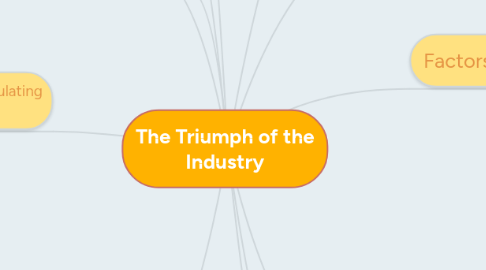
1. Josephine Cocharn
1.1. First "automatic" dishwasher
2. Key Industries
2.1. Steel
2.1.1. Bessemer Process
2.1.1.1. Andrew Carnegie adopted bessemer process to build large steel work
2.2. Communications
2.2.1. Telegraph
2.2.1.1. Samuel Morse
2.2.2. Telephone
2.2.2.1. Alexander Graham Bell
2.2.3. Transatlantic Cable
2.2.3.1. Cyrus Field
2.3. Electricity
2.3.1. Thomas Edison
2.3.1.1. Phonograph
2.3.1.2. Electric Light Bulb
2.3.1.3. Motion Pictures
2.3.1.4. Improved Battery
2.3.2. Nicola Tesla
2.3.2.1. Alternating Current
2.4. Oil
2.4.1. Edwin Drake
2.4.1.1. First Oil Drilled
2.4.2. John Rockefler
2.4.2.1. Standard Oil Company
2.5. Transportation
2.5.1. Internal Combustion engine
2.5.2. Henry ford
2.5.2.1. Reduced Costs
2.5.3. Wilbur & Oriville Wright
2.5.3.1. Airplane
2.5.4. Henry Flagler
2.5.4.1. Florida East Coast Railway
3. African-American and Women Inventors
3.1. Elijah McCoy
3.1.1. Oil-drip cup for trains
3.2. Sarah Goode
3.2.1. Fold-away bed
3.3. Garett Jordan
3.3.1. Breathing apparatus for use by firemen; a patent for a traffic signal
3.4. Lewis Howard Latimer
3.4.1. New process for making carbon filaments in light bulbs
3.5. Jan Ernst Metzelinder
3.5.1. Machine for attaching soles to shoes
3.6. Madam C. J. Walker
3.6.1. Hair-care products, especially for African-American women
3.7. Granville Wood
3.7.1. Multiplex Telegraph
4. "Captains of the Industry"
4.1. Andrew Carnegie (steel)
4.1.1. Steel
4.2. John D. Rockefeler
4.2.1. Oil Refining
4.3. John Pierpont Morgan
4.3.1. Financier
5. U.S. Supreme Court Cases
5.1. Munn v. Illnois
5.1.1. State governments can regulate grain elevators
5.2. Wabash c. illinois
5.2.1. State governments cannot regulate interstate railroads
6. Federal Laws Regulating buisness
6.1. Interstate commerice
6.2. Sherman Antrtrust
7. America's second industrial revolution
7.1. Emergene of National Market
7.2. Technological Innovation
7.2.1. Bessemer Process
7.2.2. Telephone
7.2.3. Telegraph
7.3. Rise of Corporation
7.4. Contributions of Entrepreneurs
8. Spread of railways
8.1. Provided cheaper transportation costs for carrying raw materials and finished goods
8.2. Provided stimulus to iron, coal, and steel industries
8.3. Forged a National Market
9. Invention vs. Innovation
9.1. Invention: to design something new
9.2. Innovation: to apply pr adopt new machines, process and/or products
10. New Business Practices
10.1. Advantages of large companies
10.1.1. Economic of scale
10.1.2. Cheaper sources of supply
10.1.3. More efficient management
10.2. Dangers of Monopoly
10.2.1. Less incentive to improve
10.2.2. Monopolists can over-charge consumers
10.3. Forms of business consolidation
10.3.1. Pooling agreement; trust; holding company
